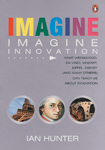Conation and innovation
 I have just started reading Imagine by Ian Hunter. The book is both an historical study of innovative people and an exploration into what the author refers to as the seven pillars of innovation: vision, creativity, knowledge, time, resources, focus and persistence.
I have just started reading Imagine by Ian Hunter. The book is both an historical study of innovative people and an exploration into what the author refers to as the seven pillars of innovation: vision, creativity, knowledge, time, resources, focus and persistence.
Ultimately, the question to be asked is what is innovation? We have traditionally associated innovation as simply encompassing new ideas, doing things differently, or entrepreneurial success. Hunter describes innovation as “the process of creating wealth from new ideas – taking what resides in your imagination and converting it into reality”. True innovation leaves changes for the better. It also involves building on and developing ideas that have come before.
Many ideas grow better when transplanted into another mind than in the one where they sprang up.
Oliver Wendell Holmes Jnr
Looking at the seven pillars of innovation, I can see at least two that would reflect the conative domain: focus and persistence. Not only did renown innovators such as Da Vinci, Mozart, Eiffel, Disney and Wedgwood possess the necessary talent and develop skills and experience to excel in their fields, but they also had the volition and persistence to overcome obstacles and make their dreams a reality. They weren’t afraid to dream and aim high, aspiring not to just being satisfactory, but for excellence. These are very much the skills and dispositions we desire for our learners. The further I explore conation, the more I see it as an essential component in learning and teaching.
The greatest danger for most of us is not that our aim is too high and we miss it, but that it is too low and we reach it.
Michelangelo
Reference:
Hunter, I. (2008). Imagine. Auckland, New Zealand: Penguin Group (NZ).




